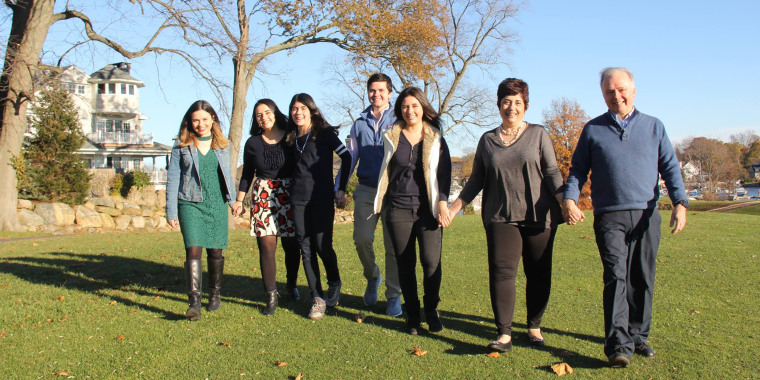The opioid and fentanyl crisis killed my brother; here’s what every family needs to know
On May 31, 2019, my life swerved off track, fell down the side of a cliff and came crashing down.
On that Friday morning, my 21-year-old brother Matt, my best friend and confidant, died. His life was taken by an apparent fentanyl poisoning in an accidental drug overdose.
We FaceTimed the evening he passed away. He was showing me and my family music he composed. The incredible melodies seemed to bounce off the wall; we were quite literally dancing and shouting with excitement.
“You have to do something with this, dude!” I remember saying, thinking to myself, wow, he has a future in this. My dad said what I was thinking out loud to him. Matt, ever shy and humble, smiled. We talked a little more, said “good night” and “I love you.” And he went to bed.
Several hours later, the next morning, I got a call from my father.
Those next few minutes — there are no accurate words. The police sirens screaming louder as they approached the house. The defibrillator. And then, the horrific, horrific silence. It keeps me up at night. Sometimes I wake up, gasping for air.
As I sit in silence now, I think about what I would tell any sister, brother, mother, father or partner who wants to protect a loved one from addiction. Anyone who might be wondering, does my loved one have a problem? What can I do?
I can think of six things everyone needs to know. They are not simple or easy to do. And sadly, they do not guarantee anything, because at the end of the day, addiction is a terrifyingly complicated, under-researched disease.

Before I get to my pieces of advice, there are a few facts you need to know:
Addiction can touch anyone.
In the current state of over-prescription and alleged deception by pharmaceutical companies for profit, illegal drugs, police under-funding and lack of research, no family is safe.
Addiction doesn’t care about who you are or who your loved one is. It doesn’t care that you have a loving family. It doesn’t care if you have extraordinary musical talents, intelligence, the ability to light up a room with hilarious jokes, or a deep and sincere kindness and compassion.
It does not care where you come from, the financial resources you have, or how beautiful your soul is. If you think there’s no way your family could be touched by the opioid and fentanyl crisis, please know, you’re wrong. Especially because drugs are everywhere in the U.S. Literally, everywhere.
For the first time in the country’s history, people are more likely to die from an accidental opioid overdose than a car crash, according to the National Safety Council’s analysis of CDC data. In 2017 alone, more Americans died from a drug overdose than the number who perished in the entire Vietnam War.
In addition, fentanyl poisonings are on the rise. Fentanyl is a synthetic opioid that is similar to morphine, but 50 to 100 times more potent. More and more drugs (heroin, cocaine and even counterfeit prescription pills) are being laced with it, often without users knowing, as I believe was the case with my brother.
There is no shame in the disease of addiction.
Fighting addiction is not merely a question of willpower or love.
If it was, my brother would still be alive. He attended an out-patient rehab program. His substance abuse counselor said he inspired other young people in the group to keep fighting. He went to Alcoholics Anonymous meetings. He went to church. He had a therapist.
In fact, a few days ago, I opened his laptop and found that he had searched for substance abuse support group meetings just hours before he died, shortly after saying good night to me.
(Even if he had not done those things, he was fighting. The physical and mental pull these drugs have on the body make every day a fight to stay sober.)
If personal willpower isn’t enough, then what can we do?

Steps to protect your loved one:
There is a lot that needs to be done on the pharmaceutical level and on the local, state and federal level. Pharmaceutical companies need to be accountable for pushing pills at the cost of human life. Further regulation to limit the import of drugs from overseas and online is needed. More support for law enforcement and more funding for medical research is needed. It’s an epidemic. And it’s taking our children from us.
In the meantime, here are steps you can take:
1. Do not treat opioids like you do other medicine.
My brother’s addiction started when he had a tooth extraction in high school. He was prescribed a bottle of opioids. Taking them for a few days fundamentally changed his brain; this is not uncommon or rare. Addiction can easily start in under one week; it’s a documented medical phenomenon.
To be sure, not everyone gets addicted to these drugs, and they are helpful to many living with chronic pain. Still, they are powerful, highly-potent substances:
- hydrocodone (Vicodin) or oxycodone (OxyContin, Percocet)
- oxymorphone (Opana)
- codeine ( Acetaminophen-Codeine, Tylenol-Codeine)
- morphine (Kadian, Avinza)
If anyone in your family is getting their wisdom teeth removed or having another procedure where opioids are often prescribed, consider asking for a non-addictive alternative such as Advil or Tylenol (without codeine). Or ask your doctor to only prescribe one or two pills.
Do not let opioids sit by your teen’s bedside or in your family bathroom. And know the number of pills in the bottle at all times. Throw them out after your loved one recovers, preferably at a local disposal site.
2. Know what things to look out for.
If you suspect something is going on with your family member, trust your gut. And know the behavioral signs. Is he or she missing classes? Sleeping all the time? Withdrawing from friends? Acting more aggressive? While these behaviors may be indicative of an underlying mental health problem — depression or anxiety, for example — and not necessarily signs of addiction, getting them help is good for them, either way.
Be aware of common items used to take drugs or hide drug use.
Addiction can easily start in under one week.
Talk to your loved one, show them you care. Tell them you love them and that’s why you’re concerned. Ask them what’s going on.
Matt knew his sisters and parents loved him so very much, and for that I am eternally grateful.
3. Write down the red flags.
One thing I wish I had done was keep a written list of all the small warning signs. Perhaps I could have had a clearer picture of what was going on earlier.
It’s one thing to make a mental note; it’s another to have a concrete list you can share with a professional therapist, doctor or substance abuse expert.
List the date and jot down your observations in a journal or on your phone. Are you noticing increased sleepiness? Missing cough medicine or eye drops? Did you find a small baggy or spoon?
Bring them to a professional’s attention.
4. Ask for help. Then ask again.
Know that you’ll be torn between feelings: wanting to love them, and wanting to get angry at them. Wanting to trust them, wanting to take control. Wanting to believe them and wanting what’s best for them. It’s exhausting. Get professional help.
Talk to your doctor, get a therapist, find a local addiction specialist. Get a second or third opinion on what next steps to take. (For example, when deciding whether to do in-patient or out-patient rehab.)

5. Get Naloxone (Narcan) as soon as you can.
Naloxone (Narcan) blocks or reverses the effects of an opioid overdose — and it’s free or available at a low-cost.
It is non-addictive nasal spray (or injection) and there are virtually no known risks, even if a person is given it when they have not consumed any opioids. If administered with minutes after an overdose, it can save your loved one’s life.
The best way to find this life-saving drug for free (or cheap) is to search on Google “Narcan training” or “free Naloxone” with the name of your state.
Most states have free sessions that teach you how to administer the drug.
My family had Narcan in the house. And we used it. It breaks my heart to say that, even with this drug, no family is safe. Still, it removes one of the many “what ifs” that I grapple with.
6. Purchase fentanyl test strips.
There are cheap, easy-to-use fentanyl test strips that can detect whether a drug or fake prescription pill has been laced with the deadly substance. I wish I had known these existed earlier.
A recent John Hopkins University/Brown University study showed that the testing strips could detect the presence of fentanyl nearly 100 percent of the time. What’s more, researchers found that the vast majority of users who found out their drug was laced with fentanyl were deterred from using it.
If you suspect your loved one is using drugs, give them fentanyl test strips. Of course, it’s something no one ever wants to do, but it could save his or her life. You could say something such as, “Here are some fentanyl testing strips. I hope you never have to use them, but they are here.”
According to the Johns Hopkins researchers, “the highly accurate strips hold potential for a public health approach to the overdose crisis.”
To be sure, testing an opioid or other drug for fentanyl does not prevent an overdose. Opioids themselves, alcohol itself, can be deadly. But testing a drug for fentanyl can remove another risk factor for users.
Addiction is a disease. Opioids and fentanyl are an epidemic. We need to work together to reverse a trend that is destroying families and casting a dark cloud over this country.
This article appeared in Today. Read more here.